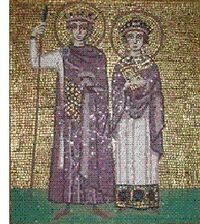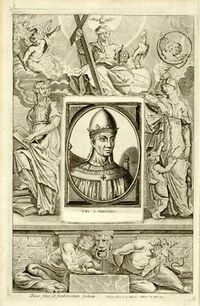Second Council of Constantinople
The Second Council of Constantinople, convened in 553 by the Byzantine emperor Justinian I, was a major attempt to square the Christian circle created by the Council of Chalcedon a century before. Now, everyone knows a square peg does not go into a round hole without a large sledgehammer. However, this was Justinian's bash, and none of the invitees saw fit to criticise his theological tool box. It now seen as an attempt to please the spirit of his late wife Empress Theodora who had batted for the other side in their marital/religious arguments. Shame she had died in 548.
The Pope says No[edit]
Justinian convened the council in his capital city for 553. The council sought to re-unite two rival Christian ideologies as regards the human/divine nature of Jesus:
- The Catholic/Eastern Orthodox (and later Protestant) side
- The Monophysite Christian tradition.
Justinian's plan was to weld together something workable, convince a majority of Christian leaders of its truth, and then execute/kill/persecute anyone who refused.
Bishops and various other clerics (as it was an all-expenses-paid trip) came along for the ride. Some bishops happened to already be in Constantinople, including Pope Vigilius, who was there to escape the Goth Wars then ravaging Italy. (Black never really suited Vigilius, either.) Justinian sent a special invitation to the Pope to participate in the council, but Vigilius smelt possible heresy and said the meeting couldn't go ahead without him. The other bishops ignored him. Justinian accepted Vigilius's regrets. He locked him up instead.
Significantly, no representatives from the Monophysite church were invited either. The last time they had sent their people to one of these meetings, people were imprisoned. So whatever this council was going to do, it would be talking amongst themselves or be like like Pope Vigilius, chained up in a prison (Papal government version) or in a palace arrest (Byzantine government version) in plush surroundings.
Retrograde punishment[edit]
The council got down to business. It did some re-emphasising the existing orthodoxy and deciding on the size of holy sacraments. Then two books and a stamp addressed letter with a single sheet inside were put on a table. These were works by previous church fathers from the 5th century who were judged to be supporters of a former Bishop of Constantinople Nestorius. Though Nestorius's own theological faith salad about the nature of Jesus Christ had been rejected (and burnt), other writers said to be in that tradition got a life time ban and retrospective damnation. The three men tipped into this hellfire hole were Theodore of Mopsuestia, Theodoret of Cyrus and Ibas's letter to Maris taking about bathroom fittings. That all three men were also dead as well didn't matter as theologians believed by posthumously condemning their writings, their spirits would be reassigned to hell.
Three Chapters[edit]
So to recap. This council was called by an emperor trying to find a formula to unite the christian church without inviting one side to contribute. Now it concentrates on the works of three christian writers - Theodore of Mopsuestian, Theodore of Cyprus and Ibas of no fixed holy address - who had been judged to be more more sympathetic to the Nestorian view of Jesus as two distinct personalities with their own views and attitude to life, the universe and cheese. Those who subscribed to this theology were tipped out the main church at Council of Ephesus. It was that and the view that Mary wasn't good enough to be a mother of Jesus's divine nature that had got them sent to the corner. According to their critics, these heretical doodlings could be found at their most damnable in everything Theodore of Mopsuestian had written, some of the work of Theodore of Cyprus before he apparently changed his mind and a single letter that Ibas had sent to a church. Ibas's letter had been passed as orthodox earlier by the Council of Chalcedon but now it was considered to be heterodox as regards the true nature of Jesus. It was added to the pile to be burnt.
Since this was Justinian's council and had long ago condemned these writers ten years earlier on the exact same ground, it was a bit of a forgone conclusion that these works were now judged to be dangerous literature for all Christians. Since the writers couldn't turn up person to defend themselves, the Council passed their condemnations without a vote. Emperor Justinian then remembered to ask Pope Vigilius - still in prison - for his support. Vigilius refused to comply, insisting he should have his three solidi worth of argument before this had gone ahead. He resisted for a little bit longer but finally caved in at the end of 553. Justinian had his verdict. Nestorians were condemned all over again and all those supporting them (either alive or dead) had better watch their mouth.
The Monophysite response[edit]
Standing outside all of this, the Monophysite Christians rejected Justinian's unity council. Though they were quite happy to see the 'full-spread Nestorians' get another of heap of manure loaded onto them, they still regarded themselves as the true church, and that all those who supported the Chalcedonian definition of Jesus were, at best, 'semi-Nestorians'. They were also running their own church network in direct opposition to the official one. For example, since the 450s there had been two lines of Patriarchs of Alexandria fighting over the ownership of the church, with regular riots, disorder, and digging up each other's venerated leaders and throwing their bones to the dogs.
Aftermath[edit]
As is evident, this council didn't settle anything but attempts by future Byzantine emperors to find a magic formula to unite all christians again carried on for another century+plus. This would later lead to the creation of Monothelitism. Woefully, the minutes of the council meeting were soon lost. Versions of the minutes exist in Latin and in English, which are undoubtably faithful renditions of the original, including the annotations and commentary. The Latin version was written by or for Pope Vigilius to read on his way back to Rome, but he had only got as far as Sicily before curling up his papal slippers.
None of the surviving documents say anything about the debate on Origenism[1] , but theologians generally explain this by assuming the bishops worked that stuff out in the car park before entering the building. At any rate, the condemnation of Origenism made by the Second Council got the "assent" of the Third Council, so that should just about drive a stake through it.
References[edit]
- ↑ Origen was a theologian from Alexandria famous for his bible commentaries and self-castrating after a literal reading of the Book of Matthew which apparently said only eunuchs got to heaven.
| Preceded by: Council of Chalcedon |
Christian Councils 553 |
Succeeded by: Third Council of Constantinople |


